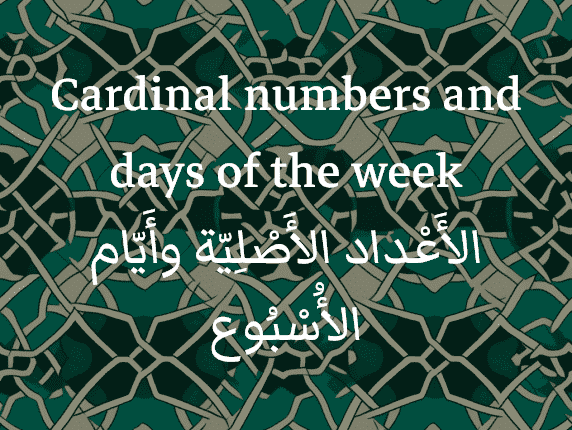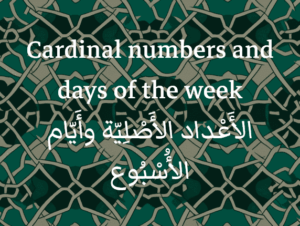Cardinal numbers / الأَعْداد الأَصْلِيّة

Cardinal numbers in Arabic are quite complex and many Arabic native speakers make errors in using them, that’s why most pronounce them the dialectal way with simplified grammar. For that very reason, we’re going to divide the lesson about cardinal numbers into three parts. This part under the Beginner section will deal with the counting system in Arabic. A second lesson under the Intermediate section will focus on ordinal numbers, fractions and the expression of time. Lastly, a third part under the Advanced section will deal with the numbers noun cases’, and gender agreement with the noun they qualify.
There are two different ways to write numbers in Arabic. We have on the one hand the Eastern Arabic numerals used in the Middle East and the Arabic Peninsula. On the other hand, we have the Western Arabic numerals used in North Africa. You can read more about it in our article over here. Those latter are the ones used in most of the World nowadays. For more information about that, please check our dedicated page.
| Eastern Arabic Numerals | ٠ | ١ | ٢ | ٣ | ٤ | ٥ | ٦ | ٧ | ٨ | ٩ |
| Western Arabic Numerals | 0 | 1 | 2 | 3 | 4 | 5 | 6 | 7 | 8 | 9 |
Units / وَحَدات
0 to 10
- 0: does not vary in gender but varies in noun case
- 1 to 10: numbers can vary in gender and noun case.
| ٠ | ١ | ٢ | ٣ | ٤ | ٥ | ٦ | ٧ | ٨ | ٩ | ١٠ | |
| 0 | 1 | 2 | 3 | 4 | 5 | 6 | 7 | 8 | 9 | 10 | |
| صِفْر | واحِد (adj.) | أَحَد (noun) | اِثْنانِ / اِثْنَيْنِ | ثَلاثة | أَرْبَعة | خَمْسة | سِتّة | سَبْعة | ثَمانِية | تِسْعة | عَشْرة |
11 to 19
- 11 to 19: the numbers are indeclinable (مَبْنِية) with a final fatḥa but can vary in gender.
| أَحَدَ عَشَرَ | ١١ / 11 |
| اِثْنا عَشَرَ / اِثْنَيْ عَشَرَ | ١٢ / 12 |
| ثَلاثةَ عَشَرَ | ١٣ / 13 |
| أَرْبَعةَ عَشَرَ | ١٤ / 14 |
| خَمْسةَ عَشَرَ | ١٥ / 15 |
| سِتّةَ عَشَرَ | ١٦ / 16 |
| سَبْعةَ عَشَرَ | ١٧ / 17 |
| ثَمانيةَ عَشَرَ | ١٨ / 18 |
| تِسْعةَ عَشَرَ | ١٩ / 19 |
Note: in Arabic, the unit is pronounced before the ten.
Tens / عَشَرات
- 20 to 90: These are the masculine sound plurals of the number nouns from 3 to 9 except 20 which is the plural of 10 (عِشْرون).
| عِشْرُونَ | ٢٠ / 20 |
| ثَلاثُونَ | ٣٠ / 30 |
| أَرْبَعُونَ | ٤٠ / 40 |
| خَمْسُونَ | ٥٠ / 50 |
| سِتُّونَ | ٦٠ / 60 |
| سَبْعُونَ | ٧٠ / 70 |
| ثَمانُونَ | ٨٠ / 80 |
| تِسْعُونَ | ٩٠ / 90 |
- 21 to 29: To create intermediate numbers, the unit’s name is written first followed by its tens. These two components are combined using و and must be declined in accordance with standard rules of grammar.
| واحِد وَعِشْرون | ٢١ / 21 |
| اِثْنان/اِثْنَيْنِ وَعِشْرون | ٢٢ / 22 |
| ثَلاثة وَعِشْرون | ٢٣ / 23 |
| أَرْبَعة وَعِشْرون | ٢٤ / 24 |
| خَمْسة وَعِشْرون | ٢٥ / 25 |
| سِتّة وَعِشْرون | ٢٦ / 26 |
| سَبْعة وَعِشْرون | ٢٧ / 27 |
| ثَمانية وَعِشْرون | ٢٨ / 28 |
| تِسْعة وَعِشْرون | ٢٩ / 29 |
| Same process until 99… | |
Hundreds / مِئات
- 100 have the alternative writing مائِة but is still pronounced the same way.
- 200 is written in the dual form of 100
- 300 to 900: units are written as prefixes to 100, without bearing the ة. They are considered as 1st term of annexation while 100 is considered 2nd term of annexation, hence always in the genitive case (مَجْرور).
| مِئة / مائة | ١٠٠ / 100 |
| مِئتان / مِئتَيْن | ٢٠٠ / 200 |
| ثَلاثُمِئةٍ | ٣٠٠ / 300 |
| أَرْبَعُمِئةٍ | ٤٠٠ / 400 |
| خَمْسُمِئةٍ | ٥٠٠ / 500 |
| سِتُّمِئةٍ | ٦٠٠ / 600 |
| سَبْعُمِئةٍ | ٧٠٠ / 700 |
| ثَمانُمِئةٍ | ٨٠٠ / 800 |
| تِسْعُمِئةٍ | ٩٠٠ / 900 |
Note: Even though units are pronounced before tens, the hundreds (and above) always come first, the natural order is then:
hundreds → units → tens.
سِتُّمِئةٍ واثْنَانِ وعِشْرُونَ 622 (year of the hijra)
Thousands / آلاف
1 000 to 10 000:
- 2 000 is written in the dual form of 1 000
- 3 000 to 10 000 are written with units followed by the plural form of 1 000
| أَلْف | ١٠٠٠ / 1 000 |
| أَلْفان / أَلْفَيْن | ٢٠٠٠ / 2 000 |
| ثَلاثةُ آلاف | ٣٠٠٠ / 3 000 |
| أَرْبَعةُ آلاف | ٤٠٠٠ / 4 000 |
| خَمْسةُ آلاف | ٥٠٠٠ / 5 000 |
| سِتّةُ آلاف | ٦٠٠٠ / 6 000 |
| سَبْعةُ آلاف | ٧٠٠٠ / 7 000 |
| ثَمانِيةُ آلاف | ٨٠٠٠ / 8 000 |
| تِسْعةُ آلاف | ٩٠٠٠ / 9 000 |
| عَشَرَةُ آلاف | ١٠٠٠٠ / 10 000 |
11 000 to 999 999:
Starting from 11 000 numbers are written thousands are written in the singular form in the indefinite accusative case (مَنْصُوب)
| أَحَدَ عَشَرَ أَلْفًا | ١١٠٠٠ / 11 000 |
| تِسْعَةٌ وَعِشْرونَ أَلْفًا | ٢٩٠٠٠ / 29 000 |
| أَرْبَعُمِئةٍ أَلْفًا | ٤٠٠٠٠٠ / 400 000 |
| etc… | |
Note: Following the same logic the hundreds, thousands, and what’s above will continue to come first, the natural order is then:
thousands → hundreds → units → tens.
1187 (date of conquest of Jerusalem by Saladin) أَلْفٌ وَمِئةٌ وسَبْعةٌ وثَمانُون 999 999 تِسْعُمِئةٍ وَتِسْعَةٌ وَتِسْعونَ أَلْفًا وَتِسْعُمِئةٍ وَتِسْعَةٌ وَتِسْعونَ
Millions and billions / المَلايِين و البلايِين
Millions
| A million | مِلْيُونَ |
| Two millions (dual form) | مِلْيُونَانِ / مِلْيُونَيْنِ |
| Millions (more than 2) | مَلايِينَ |
Number order:
Millions → thousands → hundreds → units → tens
Billions
There’s two variations for the word billion in Arabic; either the literal English translation بِلِيون or the literal translation from the French word “milliard” مِليار
| A billion | مِليار / بِلْيُونَ |
| Two billions (dual form) | مِليارانِ / مِلياريْنِ / بِلْيُونَانِ / يِلْيُونَيْنِ |
| Billions (more than 2) | مِليارات / بَلايِينَ |
Number order:
Billions ? millions ? thousands ? hundreds ? units ? tens
Days of the week / أيّام الأُسْبُوع
Every day of the week is represented by a distinct combination of the word for ‘day’ (يَوْم) and numerical forms, with Friday and Saturday as exceptions that possess their own titles. The term يَوْم may sometimes be omitted from this annexation construction known as إِضافة.
| Sunday | (يَوْمُ) الأَحَد |
| Monday | (يَوْمُ) الاِثْنان |
| Tuesday | (يَوْمُ) الثُلاثاء |
| Wednesday | (يَوْمُ) الأَرْبِعاء |
| Thursday | (يَوْمُ) الخَمِيس |
| Friday (litt. day of the gathering) | (يَوْمُ) الجُمُعة |
| Saturday | (يَوْمُ) السَبْت |
Note: In Arabic, the week doesn’t start with Monday but Sunday, being the first day.
Note 2: Friday is called day of the gathering (يَوْم الجُمُعة) in Arabic as it’s the day Muslims are supposed to all gather at the mosque to listen to the imam’s speech and pray the noon prayer together.
Cardinal numbers and days of the week

Master the basics of Arabic numbers and days of the week with our comprehensive guide. Learn the cardinal numbers and their usage in different contexts, as well as the days of the week and how to express them in Arabic.
Course Provider: Organization
Course Provider Name: ArabiKey
Course Provider URL: https://arabikey.com
5

Responses